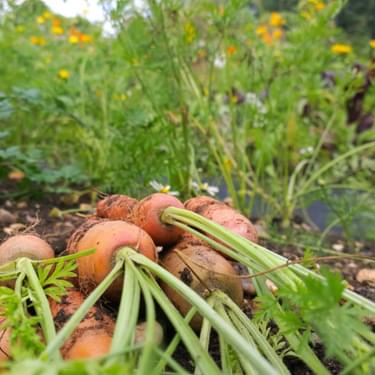
Carrot
| Growing calendar | |
|---|---|
| Sow outdoors | Feb-Jun |
| Harvest | Jun-Nov |
How to grow carrots
Regularly sowing seed 1cm deep in rows 10-15cm apart is the easiest way to grow carrots. Thin carrot seedlings to 7cm. Remove thinnings to avoid attracting carrot root fly. Choose deep sandy soil for long, straight roots.
Remove weeds by hand. Water fornightly in dry weather for steady growth. If left dry for too long, sudden watering or rain can cause the roots to split open.
Harvesting and using carrots
For the sweetest flavour, start lifting roots 12-16 weeks after sowing when they are small. Twist off the leaves rather than cutting. Carrots store well, and can be left in the ground over winter if covered with straw or cardboard.
Tips for growing carrots
Carrot fly larvae can make a meal of your carrots (and other roots). They leave rusty rings around the taproot, which can make them rot more easily and become inedible.
Sow after May, and harvest before August, to avoid the two generations of carrot flies; net crops; or sow companion plants such as parsley to muffle the carrot aroma, which attracts the egg-laying females. You can also sow in containers, so the crops are raised above the ground and avoid the fly runways.
Saving carrot seed
Carrots are biennial and in their second year produce spectacular ‘umbels’ made up of many tiny flowers. They will easily cross-pollinate with other carrots in flower, and also with the wild carrot, so need to be isolated. Read our full seed saving guidelines here.
| Growing notes | |
|---|---|
| Difficulty | Easy |
| Germination time | 17 days |
| Average time to harvest | 10 weeks (early), 16 weeks (maincrop) |
| Equipment needed | Horticultural fleece |
| Average plant size | 30cm tall, 15cm wide |
| Family group | Apiaceae: parsnip, celery |
| Latin name | Daucus carota |
| Key nutritional content | Vitamin A |
| Seed saving notes | Biennial, needs isolation |